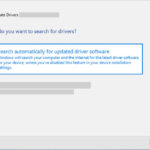Removing wind sound in Premiere Pro can be a daunting task, but it’s definitely achievable with the right techniques. At streetsounds.net, we understand the importance of clean audio for your projects. We’ll guide you through several methods to eliminate wind noise and enhance your audio quality, ensuring your soundscapes are pristine and professional.
1. Understanding the Challenge of Wind Noise
Wind noise is a common problem in outdoor recordings, caused by the movement of air against the microphone diaphragm. This results in low-frequency rumble and sometimes high-pitched whistling sounds, which can significantly detract from the overall audio quality. According to research from the Audio Engineering Society (AES), effective wind noise reduction is crucial for maintaining clarity and intelligibility in field recordings.
1.1. Why is Wind Noise Difficult to Remove?
Wind noise presents unique challenges due to its broad frequency spectrum and unpredictable nature. Unlike static hum or electrical noise, wind interference can fluctuate rapidly, making it difficult to isolate and eliminate without affecting the desired audio signals.
1.2. The Importance of Addressing Wind Noise
Addressing wind noise is essential for ensuring that your audio is clear, professional, and engaging. Whether you’re working on a film, podcast, or music project, clean audio enhances the listener’s experience and allows your content to shine.
2. Five User Search Intents for “How to Remove Wind Sound in Premiere Pro”
- Method Exploration: Users seek various methods to remove wind noise within Premiere Pro, comparing their effectiveness and ease of use.
- Step-by-Step Guides: Users require detailed, step-by-step instructions on how to apply specific techniques for wind noise reduction.
- Plugin Discovery: Users are interested in learning about third-party plugins that offer advanced wind noise reduction capabilities.
- Troubleshooting: Users look for solutions to common problems encountered while attempting to remove wind noise.
- Best Practices: Users want to understand the best practices for preventing wind noise during recording and post-production.
3. Four Built-In Premiere Pro Methods to Reduce Wind Noise
Premiere Pro offers several built-in tools that can help you reduce wind noise. These methods range from simple frequency adjustments to more advanced noise reduction techniques.
3.1. High Pass Filter
The High Pass filter is a fundamental tool for reducing low-frequency rumble caused by wind noise. By attenuating frequencies below a certain cutoff point, you can effectively eliminate much of the unwanted noise.
3.1.1. How to Use the High Pass Filter:
- Navigate to the Effects panel and search for “High Pass.”
- Drag the High Pass filter onto the audio clip in your timeline.
- In the Effect Controls panel, adjust the Cutoff frequency. Start with a low value (e.g., 50Hz) and gradually increase it until the wind noise is reduced without negatively affecting the desired audio.
 High Pass Filter Location in Premiere Pro
High Pass Filter Location in Premiere Pro
3.1.2. Advantages of the High Pass Filter:
- Simple and easy to use.
- Effective for reducing low-frequency rumble.
- Available in all versions of Premiere Pro.
3.1.3. Limitations of the High Pass Filter:
- May affect the lower frequencies of the desired audio.
- Not as effective for complex wind noise scenarios.
3.2. DeNoise Effect
The DeNoise effect is specifically designed to reduce various types of noise, including wind. It analyzes the audio and attempts to identify and remove unwanted sounds.
3.2.1. How to Use the DeNoise Effect:
- Go to the Effects panel and search for “DeNoise.”
- Drag the DeNoise effect onto the audio clip in your timeline.
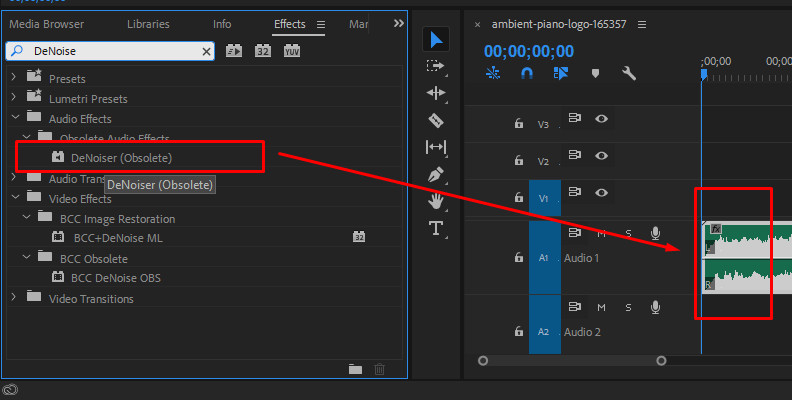 DeNoise Effect in Premiere Pro
DeNoise Effect in Premiere Pro
- In the Effect Controls panel, click Edit to open the DeNoise settings.
- Adjust the Amount slider to control the intensity of the noise reduction. You can also experiment with the Processing Focus to fine-tune the effect.
- Try some of the presets and listen to your audio clip to ensure the wind noise is removed.
3.2.2. Advantages of the DeNoise Effect:
- Designed specifically for noise reduction.
- Offers adjustable parameters for fine-tuning.
- Can be effective for a wide range of noise types.
3.2.3. Limitations of the DeNoise Effect:
- Can sometimes introduce artifacts or unnatural sounds.
- May require careful adjustment to achieve optimal results.
3.3. Parametric Equalizer Effect
The Parametric Equalizer provides precise control over specific frequency ranges. This allows you to target and reduce wind noise frequencies while preserving the integrity of other audio elements.
3.3.1. How to Use the Parametric Equalizer Effect:
- Search the effects panel for the Parametric Equalizer effect under Audio Effects > Filter and EQ and drag it to the audio clip.
 Parametric Equalizer Effect in Premiere Pro
Parametric Equalizer Effect in Premiere Pro
- In the Effect Controls panel, select Edit.
- In the Parametric EQ window, you can manually pinpoint the frequencies where the wind noise is and adjust the amount of gain, or you can use the presets, which you can customize to find the sweet spot.
- You can also select which bands to display and add a low and high cut frequency with the HP and LP options.
3.3.2. Advantages of the Parametric Equalizer Effect:
- Offers precise control over frequency bands.
- Allows for targeted reduction of wind noise frequencies.
- Can be used to shape the overall tone of the audio.
3.3.3. Limitations of the Parametric Equalizer Effect:
- Requires a good understanding of audio frequencies.
- Can be time-consuming to adjust accurately.
3.4. Essential Sound Panel
The Essential Sound Panel in Premiere Pro offers a streamlined approach to audio editing, including wind noise reduction. This panel provides easy-to-use controls and presets for common audio tasks.
3.4.1. How to Use the Essential Sound Panel:
- Enable the Essential Sound Panel from the Window menu if it isn’t enabled.
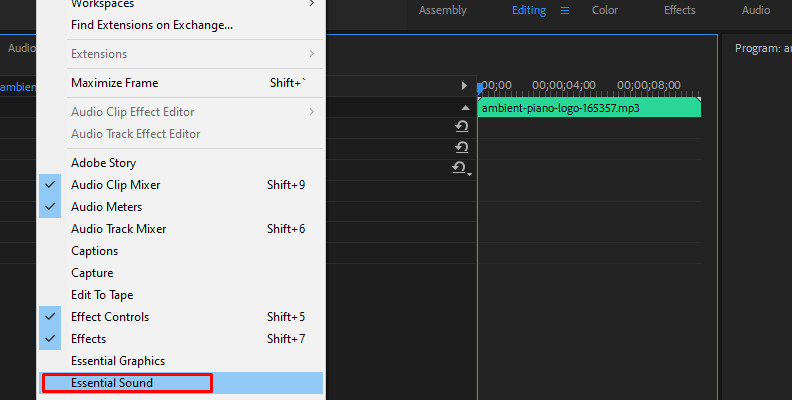 Enable Essential Sound Panel in Premiere Pro
Enable Essential Sound Panel in Premiere Pro
- Select the audio clip in the timeline and display the Essential Sound panel to see all its options.
- Click on Dialogue and choose among the effects. Reduce Rumble is great for wind noise reduction because it specifically targets low frequencies.
- Adjust the slider to set the amount of wind noise reduction to apply.
- If reducing wind noise affects the voice in the audio clip, this panel offers options to adjust the dynamics, enhance speech, and add an EQ to improve audio quality.
3.4.2. Advantages of the Essential Sound Panel:
- User-friendly interface.
- Offers presets for common audio tasks.
- Provides integrated tools for improving audio quality.
3.4.3. Limitations of the Essential Sound Panel:
- May not offer as much precise control as other methods.
- Presets may not be suitable for all wind noise scenarios.
4. Advanced Techniques: Using CrumplePop WindRemover
For more challenging wind noise situations, consider using a specialized plugin like CrumplePop WindRemover. This plugin utilizes advanced AI algorithms to identify and remove wind noise effectively, without compromising the quality of your audio.
4.1. Why Choose CrumplePop WindRemover?
CrumplePop WindRemover stands out due to its ability to intelligently distinguish between wind noise and other audio elements. It ensures that voice recordings sound natural, unlike some other methods that can introduce robotic or artificial sounds.
4.2. Step-by-Step Guide to Using CrumplePop WindRemover:
- Step 1: Apply WindRemover to Audio Clip
Look for the WindRemover on Effects > Audio Effects > VST3/AU > CrumplePop. Drag it to the video clip with unwanted wind noise. As soon as you apply it, the plug-in will analyze your audio, identify those parts with wind noise, and use the amount needed to reduce wind noise while retaining audio quality.
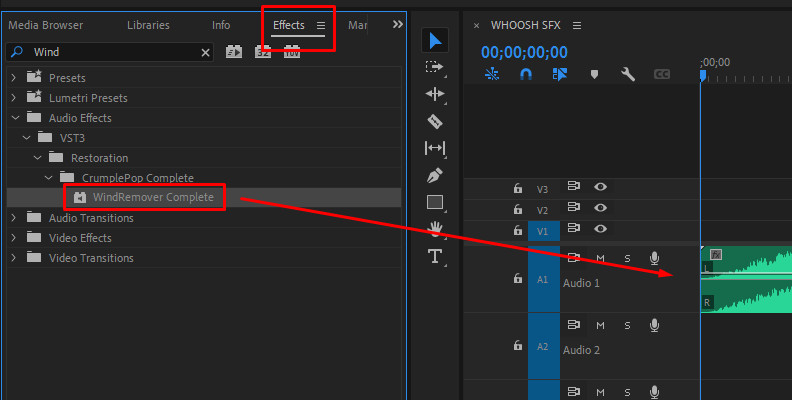 Apply WindRemover to Audio Clip
Apply WindRemover to Audio Clip
- Step 2: Adjust the WindRemover Effect
WindRemover usually does a great job removing wind noise with its default settings, but you might have audio files that require more sound customization to achieve optimal results. To remove wind noise in challenging recordings, you can adjust the amount of effect applied and control the low, mid, and high frequencies.
Click the Edit button on the effect controls panel to launch the WindRemover user interface. The big Strength central knob is the main parameter that controls how much wind noise reduction to use.
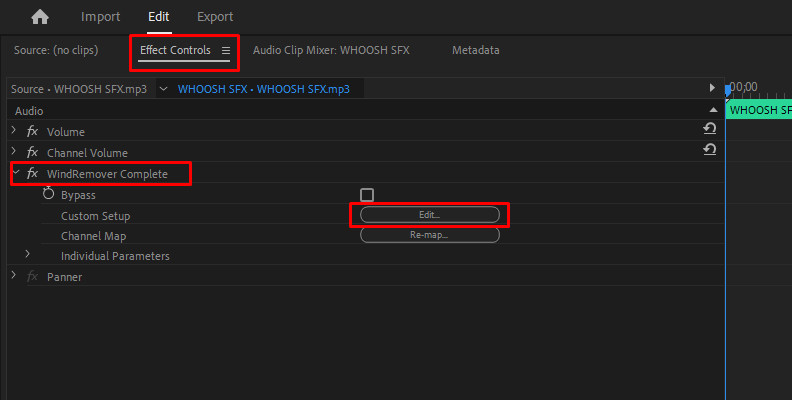 Adjusting WindRemover Strength
Adjusting WindRemover Strength
- Step 3: Work with Presets
When you find the settings you like or that work for specific situations, you can save them as presets and retrieve them whenever you find the same type of wind noise on a different audio clip.
You can save presets by clicking the disk icon and giving them a name. To use a preset, click the second icon next to the save option and select the preset you want.
Presets helps you streamline your workflow to quickly remove wind noise in Premiere Pro the next time you encounter that problem.
4.3. Advantages of CrumplePop WindRemover:
- Advanced AI-powered noise reduction.
- Maintains natural sound quality.
- Easy to use with customizable parameters.
- Preset saving for streamlining workflow.
5. Best Practices for Preventing Wind Noise During Recording
While post-production techniques are valuable, preventing wind noise during recording is the most effective way to ensure clean audio. Here are some best practices to follow:
5.1. Choosing the Right Microphone
Directional microphones are less susceptible to wind noise than omnidirectional microphones. According to research from Sennheiser, directional mics focus on sound from a specific direction, reducing the pickup of ambient noise, including wind.
5.2. Microphone Placement
Position the microphone away from direct wind sources. Shielding the microphone with natural barriers, such as trees or buildings, can also help reduce wind noise.
5.3. Using a Windshield or Dead Cat
A windshield (foam cover) or dead cat (furry cover) significantly reduces wind noise by creating a barrier between the microphone and the moving air. These accessories are essential for outdoor recording.
5.4. Monitoring Audio with Headphones
Use headphones to monitor the audio in real-time. This allows you to identify and address wind noise issues as they occur, rather than discovering them later in post-production.
6. Real-World Examples of Street Sounds and Wind Noise
Street sounds in urban environments can be particularly susceptible to wind noise. Here are some examples and how to manage them:
| Sound Type | Description | Wind Noise Impact | Mitigation Techniques |
|---|---|---|---|
| Traffic | Cars, buses, and trucks moving on city streets. | Low-frequency rumble can be exacerbated by wind. | High Pass filter, directional microphone. |
| Construction | Jackhammers, drills, and other construction equipment. | Wind can create whistling sounds around equipment. | Windshield, DeNoise effect. |
| Human Voices | Conversations, shouting, and other vocalizations. | Wind can distort speech and make it unintelligible. | CrumplePop WindRemover, monitoring with headphones. |
| Public Transportation | Trains, subways, and trams passing by. | Low-frequency rumble combined with wind can be overwhelming. | Parametric Equalizer, strategic microphone placement. |
| Street Performers | Musicians, dancers, and other entertainers. | Wind can affect the quality of musical instruments. | Windshield, directional microphone, sheltered recording location. |
7. Community Engagement at streetsounds.net
At streetsounds.net, we encourage you to explore our extensive library of high-quality street sounds. Share your experiences, ask questions, and connect with fellow sound enthusiasts. Our community is a valuable resource for learning new techniques and discovering creative inspiration.
8. SEO Optimization for streetsounds.net
To help you find the best solutions for removing wind noise and enhancing your audio, we’ve optimized this article with relevant keywords and search terms. Our goal is to provide you with the information you need to create professional-quality soundscapes for your projects.
9. Monetization Strategies for Sound Creators
Understanding how to monetize your sound creations is essential for turning your passion into a profession. Here are several strategies to consider:
- Licensing: License your sound effects and music to film, television, and game developers.
- Sound Libraries: Create and sell sound libraries on platforms like streetsounds.net.
- Freelance Work: Offer your sound design and audio editing services to clients.
- Workshops and Tutorials: Share your expertise by hosting workshops and creating online tutorials.
- Affiliate Marketing: Partner with audio equipment manufacturers and promote their products.
10. The Future of Sound Design
The field of sound design is constantly evolving, with new technologies and techniques emerging all the time. Staying up-to-date with the latest trends is crucial for remaining competitive and creating innovative soundscapes.
10.1. Emerging Technologies
Virtual reality (VR) and augmented reality (AR) are creating new opportunities for immersive sound design. Spatial audio technologies, such as Dolby Atmos and Ambisonics, are becoming increasingly popular.
10.2. Sustainability in Sound
As awareness of environmental issues grows, sustainability is becoming an important consideration in sound design. Recording ethically and using eco-friendly equipment are ways to minimize your impact.
11. Call to Action
Ready to take your audio to the next level? Visit streetsounds.net today to explore our extensive sound library, read insightful articles, and connect with a community of passionate sound creators. Discover the diverse and unique sounds of urban environments and elevate your creative projects.
Address: 726 Broadway, New York, NY 10003, United States
Phone: +1 (212) 998-8550
Website: streetsounds.net
Frequently Asked Questions (FAQ)
11.1. What causes wind noise in audio recordings?
Wind noise is caused by the movement of air against the microphone diaphragm, resulting in low-frequency rumble and sometimes high-pitched whistling sounds.
11.2. How can I prevent wind noise during recording?
Use a directional microphone, position the microphone away from direct wind sources, use a windshield or dead cat, and monitor audio with headphones.
11.3. What is the High Pass filter, and how does it help with wind noise?
The High Pass filter attenuates frequencies below a certain cutoff point, effectively eliminating low-frequency rumble caused by wind noise.
11.4. How does the DeNoise effect work in Premiere Pro?
The DeNoise effect analyzes the audio and attempts to identify and remove unwanted sounds, including wind noise.
11.5. When should I use the Parametric Equalizer for wind noise reduction?
Use the Parametric Equalizer for precise control over specific frequency ranges, allowing you to target and reduce wind noise frequencies while preserving other audio elements.
11.6. What is the Essential Sound Panel in Premiere Pro?
The Essential Sound Panel offers a streamlined approach to audio editing, including wind noise reduction, with easy-to-use controls and presets.
11.7. What is CrumplePop WindRemover, and why is it effective?
CrumplePop WindRemover is a specialized plugin that utilizes advanced AI algorithms to identify and remove wind noise effectively, without compromising audio quality.
11.8. Can I save my settings in CrumplePop WindRemover for future use?
Yes, you can save your settings as presets in CrumplePop WindRemover to streamline your workflow and quickly remove wind noise in similar situations.
11.9. What are some best practices for microphone placement in windy conditions?
Position the microphone away from direct wind sources and use natural barriers, such as trees or buildings, to shield it from the wind.
11.10. How can I connect with other sound creators and enthusiasts?
Visit streetsounds.net to explore our extensive sound library, read insightful articles, and connect with a community of passionate sound creators.

